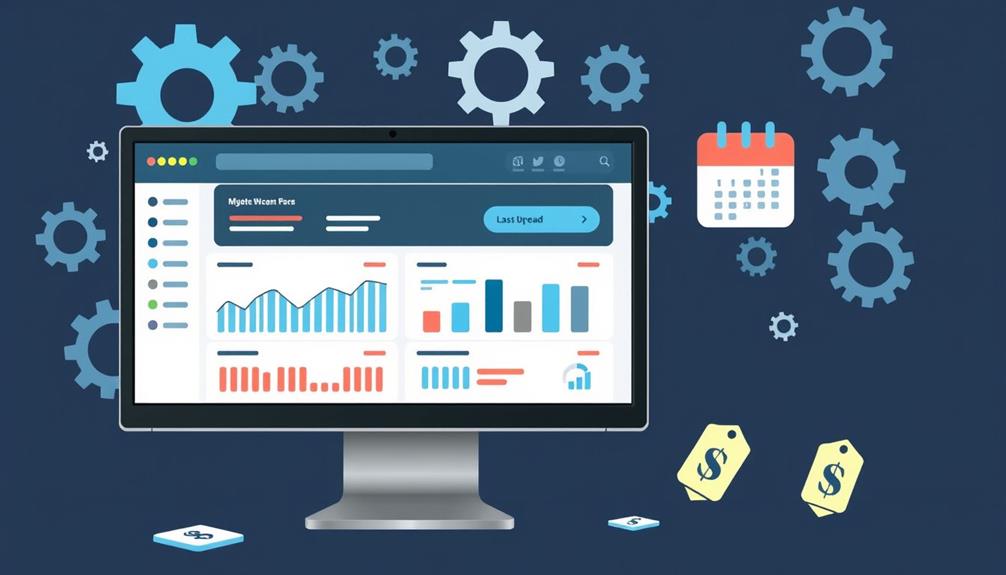The cost of a 20-page website typically ranges from $2,000 to $20,000, depending on various factors. You’ll find that developer experience, location, design complexity, and functionality requirements profoundly influence the price. Freelance developers charge $50-$150 per hour, while agency rates can reach $300 per hour. Entry-level developers may offer more affordable rates, starting at $30 per hour. Consider the benefits of an extensive website, including improved online presence, enhanced user experience, and increased conversion rates. Don’t forget to factor in ongoing maintenance costs, which can range from $500 to $2,000 per month for content updates and security patches. Understanding these elements will help you make an informed decision about your website investment.
Price Range for Developers

When considering the price range for developers, you’ll find significant variations based on several factors. Freelance developers often charge less than agencies, but rates can differ dramatically depending on the developer’s experience level, with senior developers commanding higher fees.
Additionally, location plays an essential part in pricing, as developers in high-cost areas or countries with stronger economies typically charge more than those in regions with lower living costs.
Freelance Vs. Agency Rates
The choice between hiring a freelance developer or an agency can greatly impact the cost of your 20-page website. Freelancers typically offer more competitive rates, ranging from $50 to $150 per hour, while agencies may charge $100 to $300 per hour. Why the difference? Agencies have higher overhead costs and often provide a broader range of services, including project management and quality assurance.
When considering your options, think about the complexity of your project. Do you need a team of specialists or can a single developer handle your requirements? Freelancers may be ideal for simpler websites, offering a more personal touch and flexibility. However, agencies excel at managing larger, more complex projects with their diverse skill sets and established workflows.
Experience Level Pricing
Experience level plays a crucial role in determining the cost of your 20-page website. When considering developers, you’ll typically encounter three tiers: entry-level, mid-level, and senior-level professionals. Each tier corresponds to a different price range, reflecting the developer’s expertise and efficiency.
Entry-level developers, with 0-2 years of experience, might charge $30-$50 per hour for your project. They’re driven to build their portfolio and often offer competitive rates. Mid-level developers, boasting 3-5 years of experience, generally command $50-$100 per hour. Their increased proficiency translates to faster turnaround times and higher-quality work.
Senior-level developers, with 5+ years of experience, typically charge $100-$200+ per hour. Their extensive knowledge and problem-solving skills can vastly enhance your website’s functionality and performance.
When choosing a developer, consider your project’s complexity and budget constraints. While senior developers may seem costly, their efficiency could result in fewer billable hours. Conversely, entry-level developers might take longer but offer cost savings. Remember, investing in experienced professionals often yields a more polished, scalable product. How will you balance cost and expertise for your 20-page website?
Location-Based Cost Variations
Geographic location markedly impacts the cost of hiring developers for your 20-page website. You’ll find significant price variations depending on where your developer is based. In the United States, for instance, developers in major tech hubs like San Francisco or New York City typically command higher rates than those in smaller cities or rural areas. You might pay $150-$200 per hour for a skilled developer in these high-cost areas, while the same level of expertise could cost $75-$125 per hour in less expensive regions.
Looking globally, you’ll encounter even wider cost disparities. Eastern European countries, such as Ukraine or Poland, offer skilled developers at rates ranging from $25-$50 per hour. In contrast, developers in India or the Philippines might charge $15-$40 per hour. However, when considering offshore options, you should factor in potential communication challenges and time zone differences. It’s vital to balance cost savings with your project’s specific needs and your ability to manage remote teams effectively.
Have you considered how these location-based price variations might affect your website development budget? Remember, the cheapest option isn’t always the most cost-effective in the long run.
Benefits

When you invest in a 20-page website, you’re not just paying for design and development; you’re gaining a powerful tool for your business’s growth. Your new website will considerably enhance your online presence, offering visitors an improved user experience that can lead to higher conversion rates.
In addition, a well-structured, content-rich website with 20 pages can boost your search engine rankings, making it easier for potential customers to find you online and potentially increasing your organic traffic.
Improved Online Presence
With an improved online presence, your business can reap numerous benefits. A well-designed 20-page website serves as your digital storefront, allowing potential customers to find and engage with your brand 24/7.
You’ll establish credibility in your industry, showcasing your expertise and offerings to a global audience. This enhanced visibility can lead to increased traffic, higher conversion rates, and ultimately, more revenue for your company.
Your website becomes a powerful tool for customer engagement, providing valuable information and resources that keep visitors coming back. You’ll have the opportunity to collect data on user behavior, enabling you to refine your marketing strategies and tailor your content to meet your audience’s needs.
How does this translate to real-world results? Consider the potential for expanded market reach, improved customer service through online support channels, and the ability to showcase client testimonials and case studies.
In addition, a robust online presence allows you to compete effectively with larger businesses, leveling the playing field in your industry. By investing in an extensive website, you’re not just creating a digital brochure; you’re building a foundation for sustainable growth and success in the digital age.
Enhanced User Experience
A smooth and intuitive user experience is at the heart of a successful 20-page website. When you invest in enhanced user experience, you’re not just creating a visually appealing site; you’re crafting a digital environment that welcomes and guides your visitors. This investment pays dividends in user satisfaction, reduced bounce rates, and increased conversions.
Consider these key benefits of prioritizing user experience:
- Improved navigation and information architecture
- Faster load times and responsive design
- Accessibility features for diverse user needs
- Consistent branding and visual hierarchy
By focusing on these elements, you’re building a website that resonates with your audience and keeps them engaged. A well-designed user experience anticipates your visitors’ needs, guiding them effortlessly through your content and toward your desired actions. This seamless journey not only enhances user satisfaction but also bolsters your site’s credibility and trustworthiness.
Furthermore, an optimized user experience can substantially impact your search engine rankings. Search algorithms increasingly favor sites that provide exceptional user experiences, considering factors such as page speed, mobile-friendliness, and ease of navigation. Consequently, your investment in user experience can yield long-term benefits for your online visibility and organic traffic growth.
Increased Conversion Rates
Conversion rates are the lifeblood of any website’s success. When you invest in a professionally designed 20-page website, you’re not just getting a digital presence; you’re acquiring a powerful tool to turn visitors into customers. A well-crafted site will guide users through a seamless journey, strategically placing call-to-action buttons and optimizing landing pages to encourage desired actions.
By incorporating persuasive copy, intuitive navigation, and trust-building elements like testimonials and security badges, your website can greatly boost conversion rates. Have you considered the impact of A/B testing on your site’s performance? This method allows you to refine your approach continually, ensuring that every element works harmoniously to convert casual browsers into loyal customers.
Moreover, a responsive design that adapts to various devices will capture leads across all platforms, maximizing your reach and effectiveness. Remember, higher conversion rates translate directly to improved ROI, justifying the initial investment in your website. With features like personalized content recommendations and retargeting capabilities, your 20-page site becomes a conversion powerhouse, nurturing leads and closing sales with remarkable efficiency.
Better Search Engine Rankings
Climbing the search engine ladder becomes markedly easier with a professionally designed 20-page website. Search engines favor well-structured, content-rich sites that offer value to users. Your investment in an extensive website will likely yield dividends in terms of improved search rankings, potentially leading to increased organic traffic and brand visibility.
A professionally crafted 20-page website can enhance your search engine optimization (SEO) efforts through:
- Ample opportunities for keyword optimization across multiple pages
- Improved site architecture and internal linking structure
- Increased content depth, signaling expertise to search algorithms
- Enhanced user engagement metrics, such as time on site and pages per visit
You’ll find that a larger website provides more avenues for creating quality content that addresses your audience’s needs. This content-rich approach not only satisfies search engines but also positions you as an authority in your field. By offering a wealth of information, you’re more likely to attract backlinks from reputable sources, further boosting your search engine rankings. Remember, higher rankings can translate to increased brand trust and credibility, helping you establish a stronger connection with your target audience.
Website Maintenance and Updates

When you invest in a 20-page website, you’ll need to contemplate ongoing maintenance and updates to keep it functioning ideally. Your website’s longevity and effectiveness depend on regular content updates, implementation of security patches, and performance optimization services. To understand the significance of these elements, consider the following breakdown:
| Maintenance Task | Frequency | Impact |
|---|---|---|
| Content Updates | Weekly/Monthly | Improved SEO, user engagement |
| Security Patches | As released | Protection against vulnerabilities |
| Performance Optimization | Quarterly | Faster load times, better user experience |
Regular Content Updates
Regular content updates are the lifeblood of a thriving website. They keep your site fresh, engaging, and relevant to your audience. By consistently adding new information, you’ll improve your search engine rankings and give visitors a reason to return. Importantly, regular updates demonstrate your commitment to providing value, which can foster a sense of community among your users.
To maintain a successful content update strategy, consider these key elements:
- Develop a content calendar to plan and schedule updates
- Diversify your content types (e.g., blog posts, videos, infographics)
- Encourage user-generated content and feedback
- Monitor analytics to identify popular topics and adjust accordingly
The cost of regular content updates can vary greatly based on factors such as frequency, complexity, and whether you’re creating content in-house or outsourcing. For a 20-page website, you might budget anywhere from $500 to $2,000 per month for content creation and implementation. This investment can yield substantial returns in terms of increased traffic, improved user engagement, and enhanced brand loyalty. Remember, consistent, high-quality content updates are essential for maintaining your website’s relevance and effectiveness in today’s competitive digital landscape.
Security Patch Implementation
In the domain of website maintenance, security patch implementation stands as a pivotal safeguard against potential threats. As a website owner, you’ll need to stay vigilant and proactive in keeping your site secure.
Regular updates to your content management system, plugins, and themes are essential to protect against vulnerabilities that hackers might exploit.
You’ll find that most reputable web hosting providers offer automated security patch updates, but it’s imperative to verify this service is included in your package. If not, you may need to implement these patches manually or hire a professional to do so.
The frequency of security updates can vary, but you should expect to apply patches at least monthly, if not more often.
The cost of security patch implementation can range from $50 to $200 per month, depending on the complexity of your website and the level of service provided. Remember, investing in security is far less expensive than dealing with the aftermath of a successful cyber attack.
Performance Optimization Services
Alongside security measures, performance optimization services play a key role in maintaining an excellent website. These services focus on enhancing your site’s speed, responsiveness, and overall user experience.
You’ll want to ponder implementing various optimization techniques to guarantee your 20-page website performs at its best, keeping visitors engaged and satisfied.
Key performance optimization services include:
- Minification of CSS, JavaScript, and HTML files
- Image compression and lazy loading
- Browser caching implementation
- Content Delivery Network (CDN) integration
By investing in these services, you’re not only improving your website’s performance but also boosting its search engine rankings. Search engines favor fast-loading, optimized websites, which can lead to increased organic traffic and better user retention rates.
Regular performance audits and optimization efforts are indispensable for maintaining your site’s competitive edge in today’s digital landscape.
Frequently Asked Questions
How Long Does It Typically Take to Build a 20-Page Website?
You’ll find that building a 20-page website typically takes 4-8 weeks. Your timeline depends on factors like design complexity, functionality, and content preparation. Don’t worry though, you’re not alone in this journey – many have walked this path before!
Can I Add E-Commerce Functionality to a 20-Page Website?
You can definitely add e-commerce functionality to your 20-page website. It’s a great way to expand your online presence and connect with customers. You’ll be able to showcase and sell products directly to your community.
What Hosting Options Are Recommended for a 20-Page Website?
For your 20-page website, you’ve got great hosting options! Consider shared hosting for affordability, VPS for more control, or managed WordPress hosting if you’re using that platform. Cloud hosting’s scalability might suit you too. Choose what feels right!
Is Search Engine Optimization (Seo) Included in the Cost Estimate?
You’ll find that SEO isn’t typically included in standard website cost estimates. It’s often an additional service you can opt for. If you want to boost your site’s visibility, you should consider adding SEO to your package.
Are There Additional Costs for Mobile Responsiveness in a 20-Page Website?
You’ll be glad to know that mobile responsiveness is typically included in modern web design packages. It’s essential for your site to look great on all devices, so most developers won’t charge extra for this vital feature.







